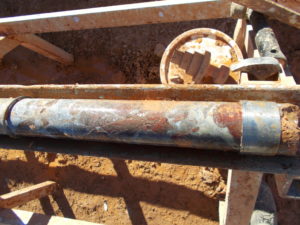 Green and yellow quartz signify the richest ore likely in the Oatman deposits
Green and yellow quartz signify the richest ore likely in the Oatman deposits
AZS updates
History book states,
Green and yellow quartz signify the richest ore likely in the Oatman deposits
Go to page 63 of the book on the following link to read about the stages of mineralization in the Oatman mining district.
http://repository.azgs.az.gov/sites/default/files/dlio/files/2010/u14/Bull_131_Oatman_OCR_0.pdf
Fourth Stage: :Although a few small crystals of quartz were depositel on calcite, as mentioned in the preceding paragraph, they were but the forerunner of the extensive deposition of the quartz that constitutes commercial ore bodies. The quartz again shows casts of platy calcite. Fig. 15 is an illustration representative of this variety of quartz. The color is invariably yellow or greenish, but the oily luster is absent except in such specimens as have a banded structure. ‘1’he banded structure is best seen where the earlier stages of mineral filling have been shattered and this later quartz introduced into the fractures.
A microscopic examination of this quartz s:Qows the individual crystals along definite lines which were originally thin plates of calcite. The space between the rows of crystals is lined with a granular aggregate of quartz grains together with ragged shreds of unreplaced calcite. Occasional grains and crystals of adularia may be seen in the granular quartz. This adularia is remarkably, free from aIterationproducts, and it is interesting to note here that the first appearance of the adularia coincides with the first deposition of commercial ore. Gold is rarely seen with a microscope and then only as widely scattered, thin flakes.
Quartz of this stage of deposition occurs at the Katherine Mine, but was not found at any of the other mines of the Katherine District. In the Oatman District, this variety of .quartz occurs at practically all the mines that have produced gold. This period of mineralization represents the first introduction of commercial values.
Assays of such quartz range from 0.20 to 1.00 ounces in gold and 0.24 to 2.34 ounces in silver per ton. The ratio of gold to silver is approximately 1 to 2.
The calcite formed upon this pseudomorphic quartz occurs as very thin lameHae which form a somewhat compact mass of curved plates. The calcite has a pearly luster and is the most distinctive variety of this mineral in all the stages of mineral deposition in these veins. A broad band of the, calcite, several inches wide, may be traversed by thin layers of the yellow quartz which show a rhythmic alteration of quartz and calcite.
Where the thin plates diverge, small, clear crystals of quartz rest on the calcite.
Fifth Stage: This stage of deposition brings to a close the active filling of the fissures by th,e mineral-bearing solutions which arose through the fractures. It is also of interest to note that the ascending solutions that deposited this last phase of mineralization also brought in the greatest concentration of gold. 1 plus oz per ton.
The vein filling of this stage of mineralization was deposited in open fissures upon the earlier stages of vein filling or upon rock fragments. Banding is well developed and crenulation in the bands is very pronounc(jd. Such banded structures are frequently referred to as “cockade are,” 26 and represents the repeated deposition of alternate layers of somewhat different composition.
The quartz of this last stage of mineralization is yellow and, often, olive-green in color. Such quartz invariably shows an oily luster, and a well-developed banded structure. The size of the quartz grains varies from fine to coarse, and, usually, the darker-colored bands are somewhat coarser in texture. The difference in color, certainly in some specimens, appears to be due to a greater concentratipn of impurities, perhaps a silicate of iron.
Layers of quartz are often separated by bands of snow-white adularia, and these partings of adularia vary in width from a small fraction of an inch up to two inches. Occasionally, the quartz and adularia are separated by a thin parting of calcite.
The thicker bands of adularia are made up of coarser crystals and, on a fractured surface, show the cleavage characteristic of this mineral. In these broader bands, the crystals of adularia have well-developed terminal faces, and, upon the ends of these the arrangement of small, opaque inclusions. A little kaolinitic dust occurs in the adularia, frequently along cleavage planes; otherwise this mineral is remarkably free from alteration products
Regards
Mike Stark, CEO, President
Arizona Silver Exploration Inc.
C 604.833.4278
W www.arizonasilverexploration.com
Suite 970 – 777 Hornby St, Vancouver, BC
Canada, V6Z-1S4






























